In the left corner - one of the holly grail standard lenses from the film era, holder of L title in the Canon World Lens League, highly sought after among lens freaks around the globe, Greaaaaaat, Faaaamooouuus, Canon FD 50mm f/1.2 L!!!!!!
In the right coooorner, there is raising star with big S, lens that just recently entered professional ring, lens that despite its seemingly slower speed, doesn't afraid to challenge even the best in the business such as Otus 55/1.4 with which it shares same Zeiss camp, all modern, all fresh, or beautiful - Ssssooooony Zeisssss FE 55mm f/1.2.
Proven build quality against fancy hi-tech materials, careful craftsmen work versus robotized precision, legendary opticians versus computerized modeling, old vs new in every respect...
Even the first look at the image above, clearly shows the giant leap in design evolution. What a shame, that Sony didn't ask Zeiss to design their A7/r cameras too :-)
Canon is actually smaller (shorter) lens, but with its E-mount adapter (as shot above), it equalize in that respect with Zeiss. However, Canon FD is slightly heavier lens.
Size might be surprising considering that FE 55/1.8 is actually full f-stop slower. There is AF of course, but thinking of Canon EF 50/1.8, Zeiss still seems bigger than necessary.
When you take caps off, the difference in speed and related glass diameter is more than evident.
Much more glass on the left, but filter diameters are not so different - Canon has 52mm, Zeiss 49mm. Kudos to Sony for being quite consistent at 49mm across the lens line, because that can save not only finance but most importantly amount of necessary equipment and allow more convenient use of filter systems. (There is nothing as annoying as looking for the proper adapter ring for LEE system, or polarizer that is surely somewhere in the backpack, but can't be found while sun is getting lower and lower...).
Even more significant difference is on the rear side of the lenses.
As you can see, Canon rear glass element is almost in the same level as the mount itself, while Zeiss is deeply recessed. Rear element is also wider (it has to deliver twice as much light) but lack of baffling might cause some flaring problems, related to the sensor reflections (it wasn't problem with the film). In my brief tests on Sony A7 (camera that has sensor reflection problems) I haven't noticed anything significant though.
Built quality of both lenses is very good, but I have to give an edge to Zeiss in that regard, it looks more refined and more importantly it is supposed to be weather sealed.
On the other hand, while Zeiss has well engineered focus ring, it is still focusing by wire, and that will never result in a subtle tactile feeling that well dampened MF focus ring gives.
Image quality
Both lenses were tested on Sony A7 in this article. (In some upcoming articles I am planning to use Sony A7r and Sony a6000 for lens test too).
Comparison 1 - resolution at peak f-stop (f/8)
Sony FE 55/1.8 Z at f/8
Click here for original - https://www.flickr.com/photos/97543230@N02/13411870183/sizes/o/
Canon FD 50/1.2 L at f/8
Click here for original - https://www.flickr.com/photos/97543230@N02/13411851865/sizes/o/
And few comparison crops at 100%
Click here for original - https://www.flickr.com/photos/97543230@N02/13412122664/sizes/o/
While in Lab Zeiss 55/1.8 Z (DxO, Photozone etc.) deliver amazing resolution results on Sony A7r and A7, in a real life, those numbers doesn't shows up that significantly. At least, I can't see some deal braking differences at f/8 from the image above.
Both lenses performs really well in this test scenario as far as I can see.
Here is another comparison scenery at f/5.6.
Sony FE 55/1.8 Z at f/5,6
Click here for original - https://www.flickr.com/photos/97543230@N02/13412165844/sizes/o/
Canon FD 50/1.2 L at f/5,6
Click here for original - https://www.flickr.com/photos/97543230@N02/13411886995/sizes/o/
And related 100% crops
Click here for original - https://www.flickr.com/photos/97543230@N02/13411882323/sizes/o/
At f/5.6, some slight edge in resolution should be given to Zeiss, but the questio is how much that is a) field relevant, b) result of slightly larger magnification (55 vs 50mm), c) differences in a focus plane.
Overall, I don't think that anyone would complain about resolution of either lens in a real life, especially when you find something more exciting to shot than I did.
Where I can see differences though is color rendition. Zeiss shifts more toward magenta while Canon toward green. While I usually like those greenish Canon colors more, I have to say, that in this case, Zeiss 55/1.8 attracts me much more.
Here is comparison shot where you can hopefully see what I am talking about
Click here for original - https://www.flickr.com/photos/97543230@N02/13413340144/sizes/o/
Not a big deal, but you can see more magenta in the sky and water on Zeiss shot, and that makes overall color feeling more appealing to me.
I also tried to apply my post processing routine to the shots above and here are related larger crops (still 100%, but larger crop from the original image).
Click here for original - https://www.flickr.com/photos/97543230@N02/13413099953/sizes/o/
There is little doubt that despite raving reviews about Zeiss 55 f/1.8 Z resolving power, one can see almost no difference at most apertures smaller than f/4 between those two lenses in that regard. But is is also obvious, that both lenses renders outstanding amount of details.
You can see original files (post processed) here - Zeiss and Canon
While those fast standard lenses are used in many photographic situations, they are most often used for shallow DOF photography. As I have no nice models to stand and pose, all I can show here is a little spring green just showing up on the trees.
Click here for original - https://www.flickr.com/photos/97543230@N02/13412132634/sizes/o/
While Canon FD 50/1.2 L wide open does blur the far background just a little bit more, what is much more apparent is its vignetting at that aperture.
Difference in DOF will be more significant if the background would be closer to the subject in focus, but than there are lenses better suited for subject isolations. In the setup above, bokeh looks OK, but nothing more than that. Don't jump on me please, both lenses delivers nice bokeh in this situation, but Canon EF 50/1.2 L is much smoother and MOG Primoplan 58/1.9 (e.g.) will go swirly circus, so both will deliver something more distinguished.
To see original images click for Canon at f/1.2, Canon at f/1.8 and Sony at f/1.8
So far, it seems that both lenses handle CA quite well too, but I am sure that in a critical conditions (high contrast areas in back light and shiny highlights in general) Zeiss will beat Canon due to moder coatings.
Finally, comparing sharpness and bokeh in the evening scene, didn't reveal any drastical differences either.
Those are crops from original images that you can check here - Canon at f/1.2, Canon at f/1.8 and Sony at f/1.8
You can see some green highlight outlines on Canon wide open which disappears stopped sown a bit, while Sony is "cleaner" in that regard. Overall Zeiss delivers more pleasing rendering of highlights in my opinion.
One thing is important to add here - Zeiss has 9 blades aperture, while Canon 8. That would be apparent at smaller apertures and it is matter of taste what you would prefer. I like 8 blades slightly more.
Who is the winner of this match?
The owner of either lens.
Both lenses are much better than I will ever be as photographer, and both will make their owners feeling special and rewarded with some signature images.
In a direct comparison I would say that I expected Zeiss to be really good and it certainly didn't disappoint, but it's rather Canon that really surprised me.
Here is my little summary:
(1-10, 10 is max)
Build Quality: Zeiss 8, Canon 8
Design: Zeiss 9, Canon 6 (no, red ring doesn't help...)
Speed (Low Light): Zeiss 7, Canon 9
Sharpness: Zeiss 9, Canon 8
Colors: Zeiss 9, Canon 7
Subject isolation ability: Zeiss 6, Canon 7
Bokeh: Zeiss 7, Canon 6
Contrast: Zeiss 9, Canon 8
Vignetting at f/1.8: Zeiss 9, Canon 9
Price: Zeiss 3, Canon 4
Not tested - flare, CA, distortion...
OK, Zeiss is better, but not by miles and Canon can be found cheaper.
If you don't need AF, investing in Canon FD 50/1.2 L is not bad idea. Unlike new Zeiss, there is only limited number of Canon 50/1.2 Ls now on the market, and there is little to break (no AF, electronic contacts, etc.) in the future, so it might retain its value better too.
Speaking about performance, in most situations you will hardly see field relevant difference and that extra stop of Canon, can be sometimes very useful.
One thing is clear - whichever you choose, you will have great lens to enjoy for years.




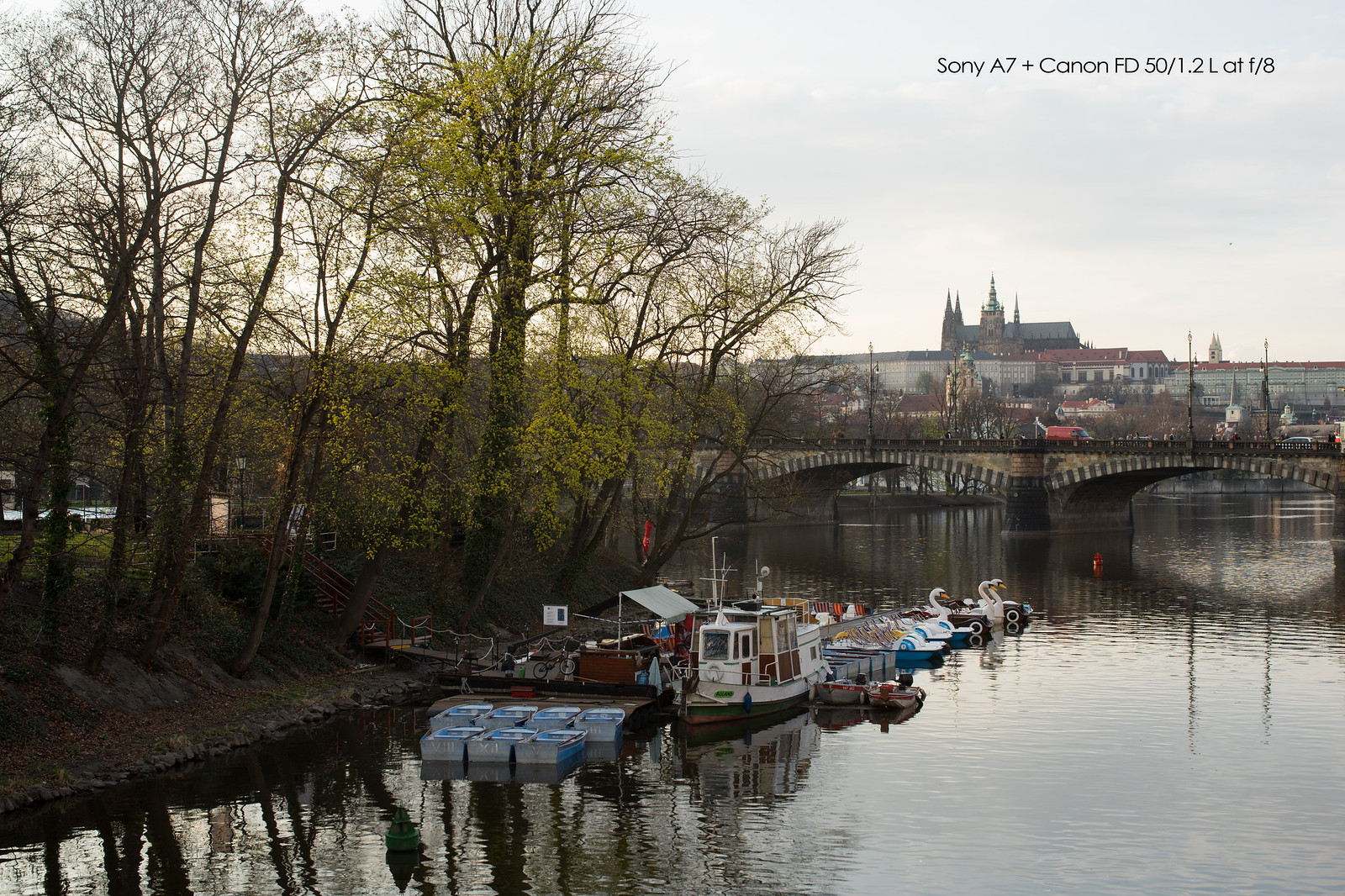
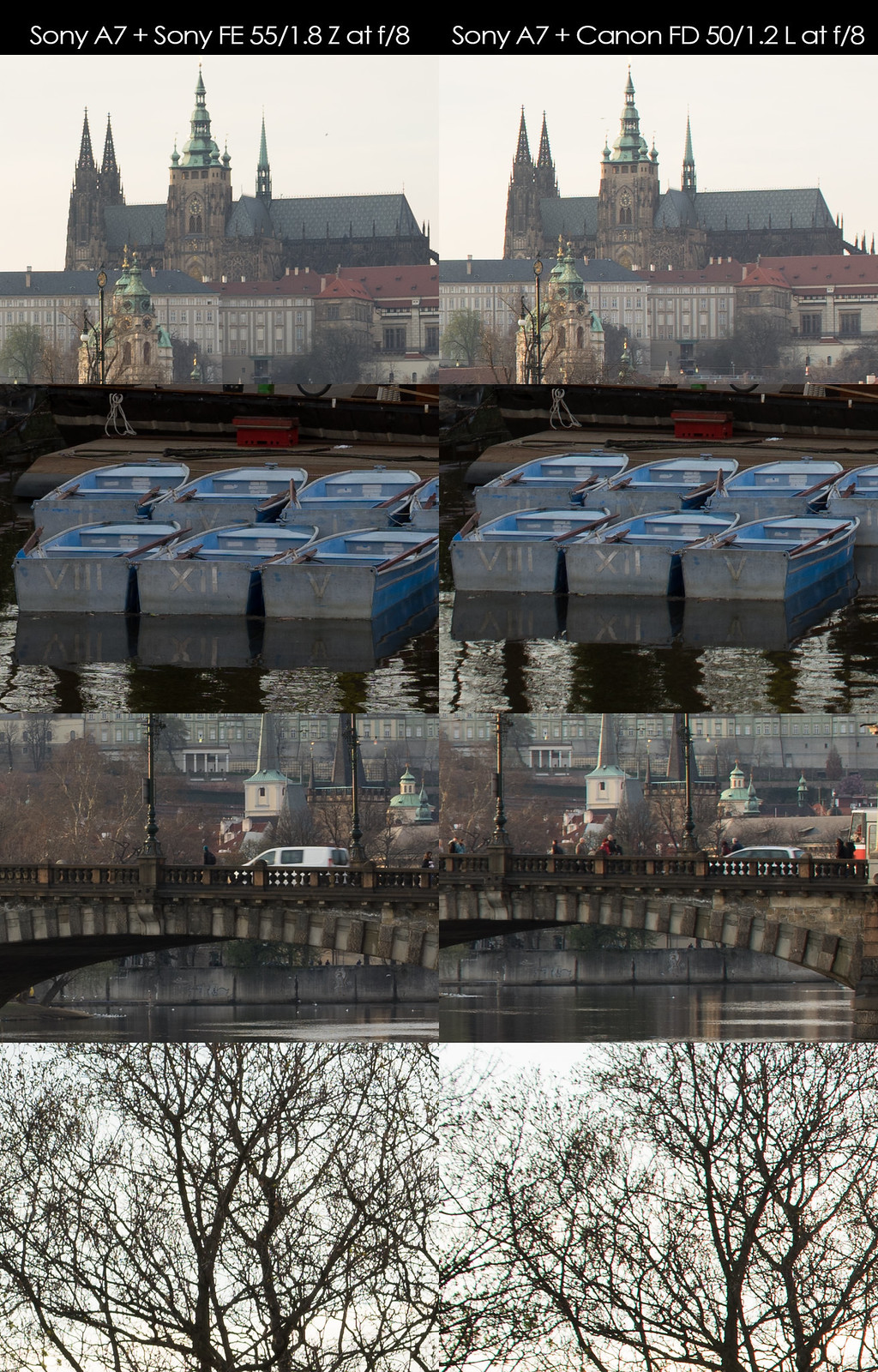
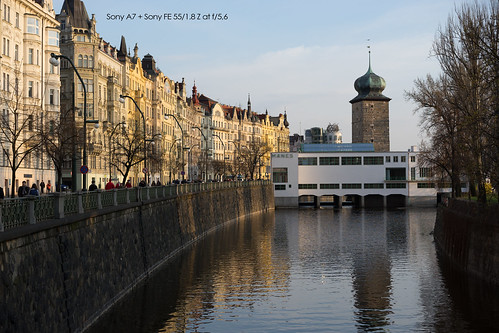


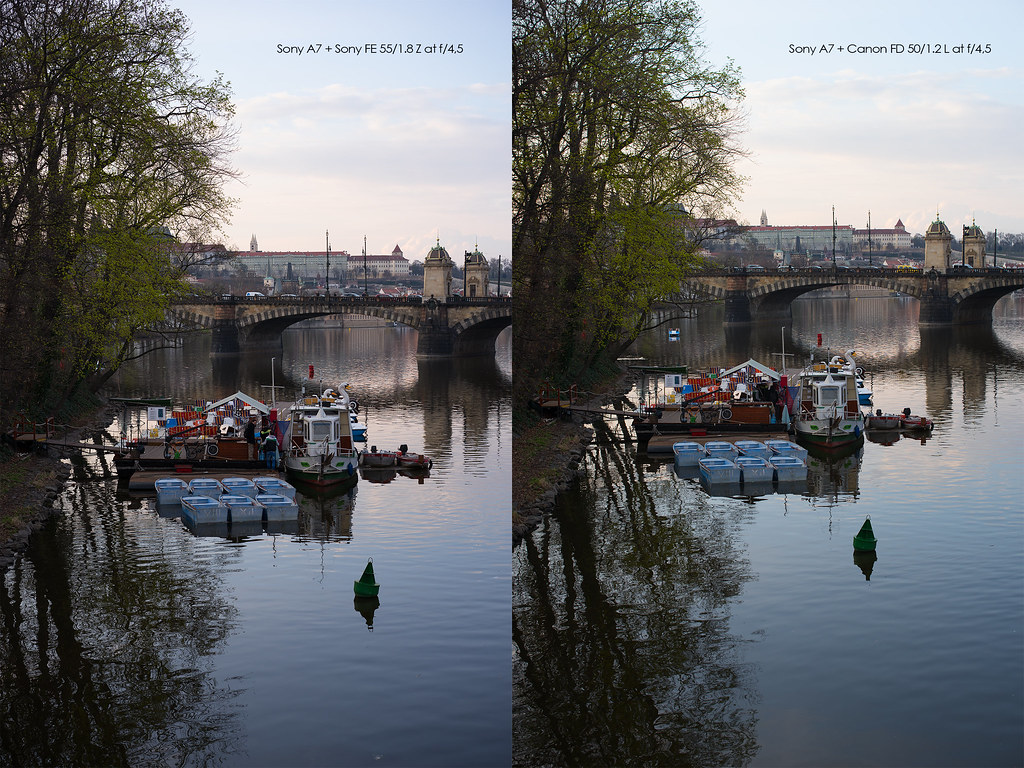
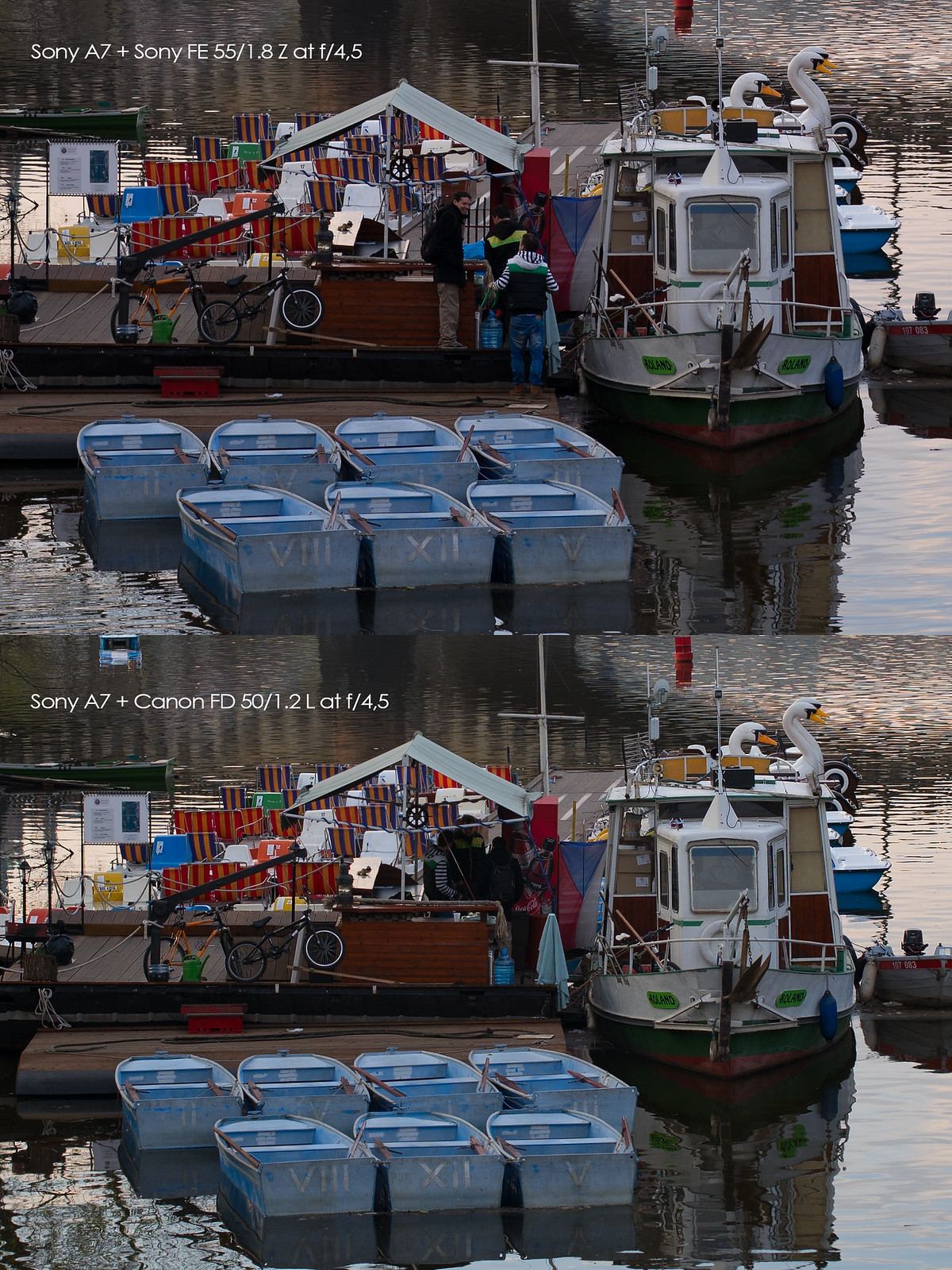

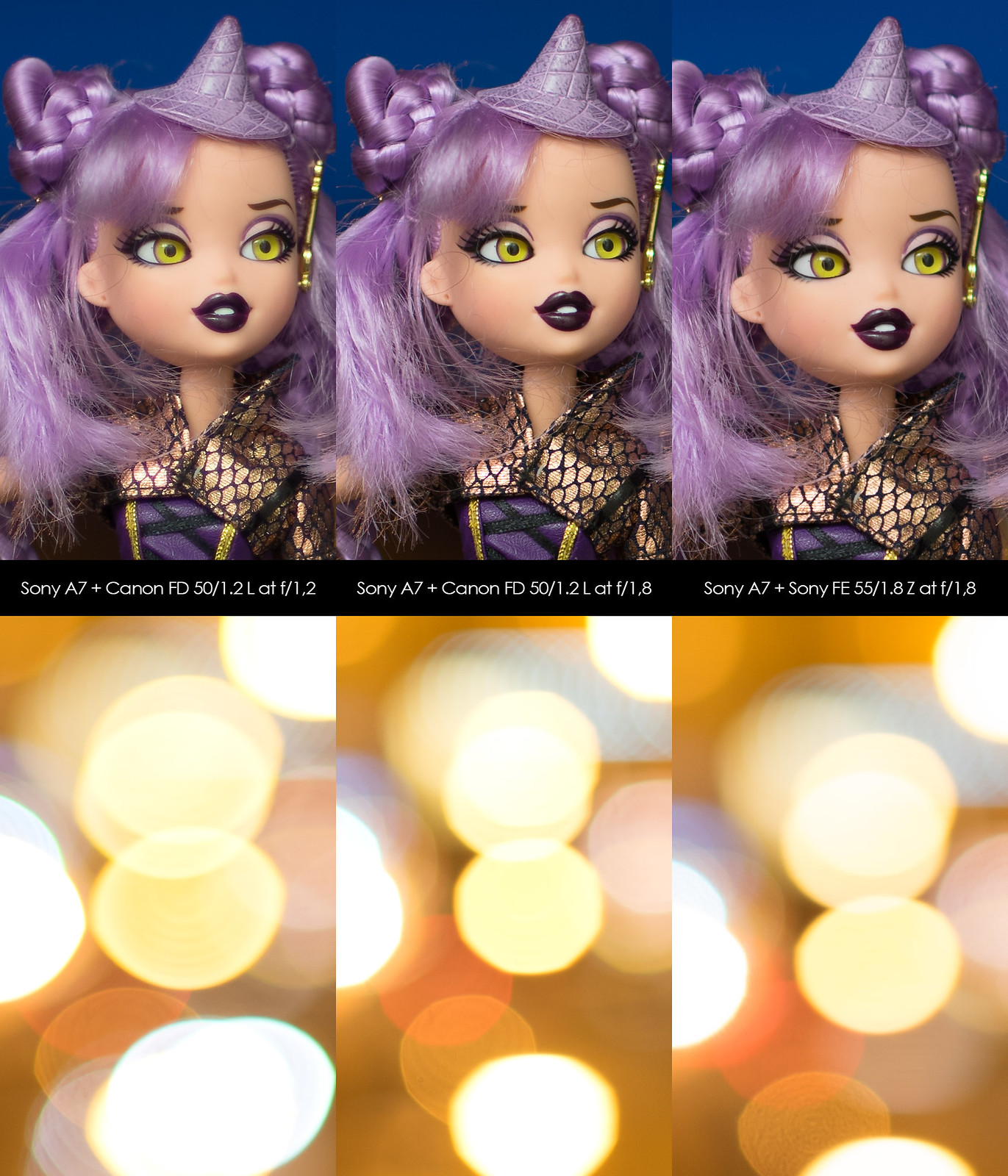
An interesting comparison. I'm not so surprised by the results - and agree with your conclusions completely. Either lens will do just fine, and surpass my photographic skills for years to come.
ReplyDeleteThis is the worst comparison EVER. Your language is biased and you are justifying most of the time for Canon. You obviously hold a large interest in Canon and failed to even mention it.
ReplyDeleteThings like "If you don't need AF"...
"in most situations you will hardly see field relevant difference" - thats because you tested this lens on the Sony A7 and not the A7r. One quick trip to DXO Mark, shows the resolving power of this lens to be much more suited for the A7r.
P.S: The zeiss lens is $500 USD cheaper.... "Canon can be found cheaper" - in used condition...
It would be nice if you don't hide behind anonymous. No reason for that, as I respect everyones opinion. I have no interest for Canon, it's not in production for many years so why would I?
DeleteEnjoy DxO figures, I am sure they will improve your photography,
Cheers,
Viktor
this quite old lens perform quite well !
ReplyDeleteGood work man and thank you !
Well, the poster does have a point; you should have compared the lenses on the A7R, for the A7R will show any faults of a lens. Also, the Zeiss is better for all the things you DID NOT test. But, as you show, the Canon gives indeed an excellent result for an older manual lens, and gives us reason to consider it when cost is a factor. I'm very impressed by your results for the Canon. But, I see the Canon lenses are rising in price, so the value in the Zeiss for say 25% price point more than the Canon is also reason to balance price/value. Another lens that is the same price now as it was when new is the Zeiss G45, which gives stellar results on the A7R. I suppose we have Sony to thank for the reason why old but very good lenses are increasing in price?
ReplyDeleteThanks for your post. I am not sure if A7r will have any significant impact on the lens IQ comparison, and I don't agree that A7r will better show faults of the lenses. Higher resolution sensor of A7r might indicate that lens resolving power is bellow sensor one, but that is not the case with those two lenses. A7r on the other hand, has serious issues with shutter shock, and that can have much stronger impact on the sharpness of the resulting files. This was the main reason why I didn't use A7r for this comparison.
DeleteI compared mainly IQ in the field, and didn't take in consideration other features such as AF, as I rarely use AF anyway. But I didn't forget to mention it in the review.
I agree about high prices for the Canon FD L (and not only those) lenses recently. That is unfortunate, because just few years back, they were available for peanuts. First system that influenced prices was MFT however. Those cameras come earlier than NEX, but new FF E-mounts probably pushed the prices further.
Hi
ReplyDeletehappy to see you back reviewing lenses !
And thanks for this interesting review.
Just to introduce :
I do own quite a few Canon FD lenses -but not this very one- and I really enjoy using them with the A7R.
I also use my Canon EF lenses on the A7R with a 'King' adapter.
I do own the Sony-Zeiss FE 55mm f/1.8 too. It is in fact the only FE lens I own (I have several E lenses for the Nex 7 though). And the only one I plan to buy.
I was hesitating to buy the Canon FDn 50mm f/1.2L but I decided to buy the Sony-Zeiss instead.
I'm happy with the decision. Main drawback of the Sony-Zeiss is, as you said, the "focus by wire" thing. I hate it.
As for the "Shutter shock" with A7R, well, anyway, if you use high enough a speed - or low enough a speed, this should not be an issue. I usually get really sharp images with the A7R. And to be honest, even if I try to stick to 1/(2x[Focal length]) or faster speed, I hardly have any shutter shock blurr, whatever speed I use.
As for the Canon FD, my favorites with A7R are
- Canon FDn 85mm f/1.2 - all times favorites
- Canon FDn 35mm f/2.0
- Canon FDn 28mm f/2.0
- Canon FDn 100mm f.2.0 (the Canon FDn 85mm f/1.8 is also good)
- Canon FDn 20-35mm f/3.5L
- Canon FDn 50mm f/3.5 Macro
- Canon FDn 80-200 f/4.0 L (with fluorite elements) - long but still light
I do own the Canon FDn 24mm f/2.0 but I'm less convinced.
The Canon FDn 135mm f/2.0 is good too but has a lot of CA when out of exact focus
NB: In general, the lens hoods on Canon FD lenses are a nightmare to use.
I've done some comparisons outdoor but have no time to publish.
I've also done several tests with Imatest but I need to improve my process.
I just come back from Italy and have mainly used the old Canon EF 16-35mm f/2.8L - because it's easier.
I was hesitating to buy the Canon FDn 50mm f/1.2L too (I own a bunch of Canon FD 50mm 1.4 and 1.8) but I decided to buy the Sony-Zeiss instead.
I'm happy with the decision. This lens is very good.
Main drawback of the Sony-Zeiss is, as you said, the "focus by wire" thing. I hate it. (As I hate the same thing on the Highly expensive but wonderful Canon EF 85mm f/1.2L II... No, I hate it more on the A7R, because I can zoom in the viewfinder and then I try to get an even better focus. 'Try' is the keyword.)
I plan to buy a Canon FD 35mm f/2.8 TS (or maybe I'll break the bank for the Canon EF 24mm f/3.5L II ?).
You're right about the prices those old lenses are reaching. I think they were mainly under-rated because it was just impossible to use them on any digital camera before the MFT/Nex came to the market.
Have a good day
Raoul
Thanks Raoul and congrats on the very nice lens collection of yours.
DeleteHi Viktor,
ReplyDeleteThanks for your comparison.
What do you think about Canon FD 55mm f/1.2 SSC Asphercial in comparison with Canon FD 50mm f/1.2 L? heard that the former performs better than the latter.
appreciate your input..
Thanks and Cheers
Gus
Hi Gus,
DeleteI still can't find that Aspherical boy for my collection, but as far as I know, it should be a ted sharper with a slightly more nervous bokeh. 50/1.2L is probably better deal, because 55/1.2 Aspherical is rather collectors item. It is also one of the most radioactive lenses within 35mm range. Thnaks for stopping by, and if you are visiting my blog more often, we moved to www.verybiglobo.com
Cheers,
Viktor
Sure Viktor, bookmarked now and will definitely visit more frequently :)
DeleteMay I ask what lens you recommend for fast 50 - 58mm MF lens in terms of sharpness, micro-contrast, bokeh and size/weight to pair with A7? I am currently using MC Rokkor 58mm f/1.2 but find it's too soft wide open hence thinking to replace it.
Are there any better options than FD 55mm 1.2 Aspherical or 50/1.2L?
Much appreciated
Cheers
Gus
Hi Gus,
Deleteyou might want to take a look at my older post - http://www.verybiglobo.com/super-fast-50-58mm-shot-out-wide-open/
It was done on APS-C camera, but you might get the idea about lens character. When it comes to sharpness wide open with super fast lenses, that's not their strong point. Within my collection of 1.2 and faster fifties, FD 50/1.2 L is certainly sharpest in the center (wide open), but the overall impression of the image and perceived sharpness will more depend on subject, background and lighting than on lens resolution itself. Even mighty Noctilux 50/0.95 is nowhere near to be called sharp wide open. Take a look at that article first and if you have any further questions, don't hesitate to keep discussion going, but preferably on the new site (I should react faster there).
BTW, probably best bang for the buck recently in terms of sharp fifty wide open (and reasonable fast) is new Sigma 50/1.4 Art. Zeiss Otus 55/1.4 is a small step above, but not as much as the price would suggest. I just recently tried that new Otus 85/1.4 on Sony A7r and man, that's sharp!!! But crazy expensive too...
Thank you for taking time to this comparison Viktor. I am really dog for 50-ties. As I got A7R, I just went through Nikkor AiS 50/1.2, Pentax SMC 50/1.2, Canon FD 55/1.2 SSC. So far, I kept Canon, as it has the nicest bokeh and rendering to me. Now, I can get 50L for about 600 USD, but I am afraid I will like it and end up with FE 50 and great Canon's. Any advice? Dziekuje
DeleteHi CalBoy87, if you have FE 55/1.8 ZA already and want another super fast 50, did you consider Mitakon 50/0.95? I am trying to get that one for testing, but so far producer didn't reply on my request. What I have seen however looks promising and in combination with FE 55/1.8 ZA, you should be cover for technically superior output as well as for artistic subject isolation. If you don't have FE 55/1.8 ZA, then Canon FD 50/1.2 L can give you a taste of both worlds :-)
Deleteregards,
Viktor